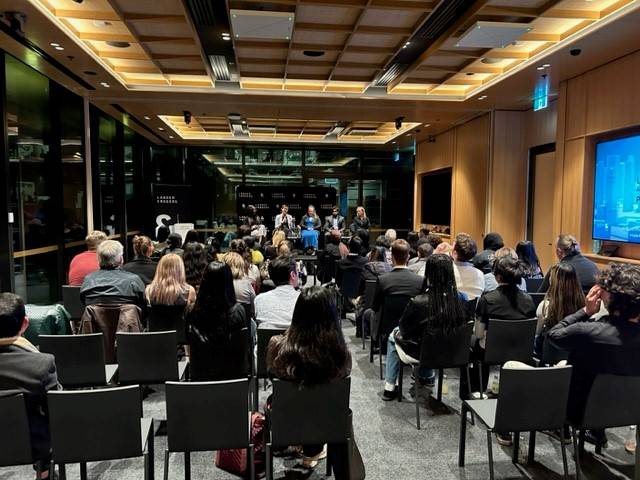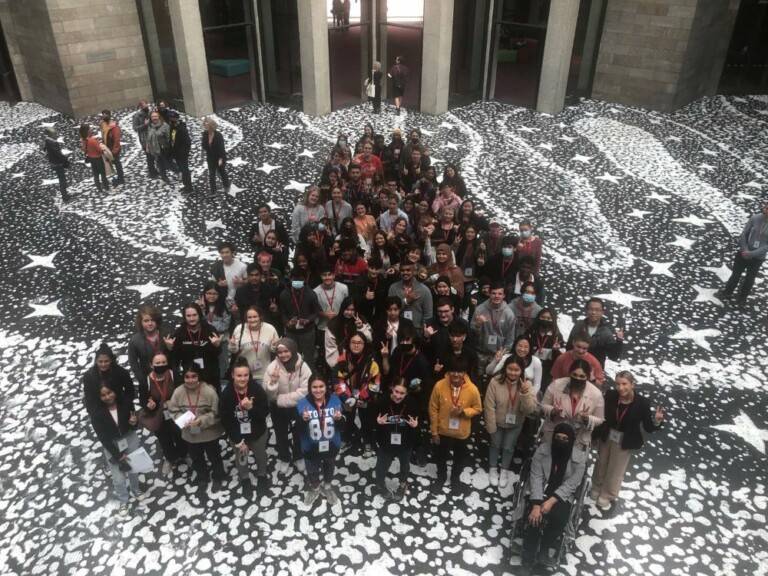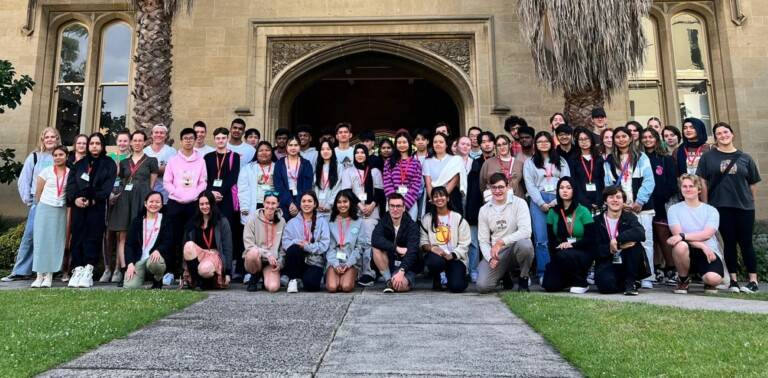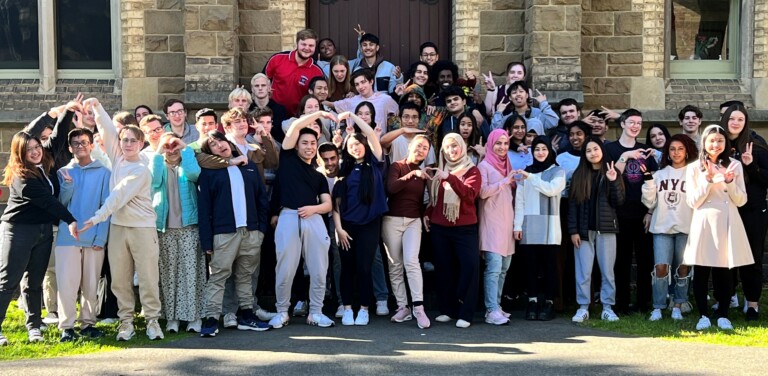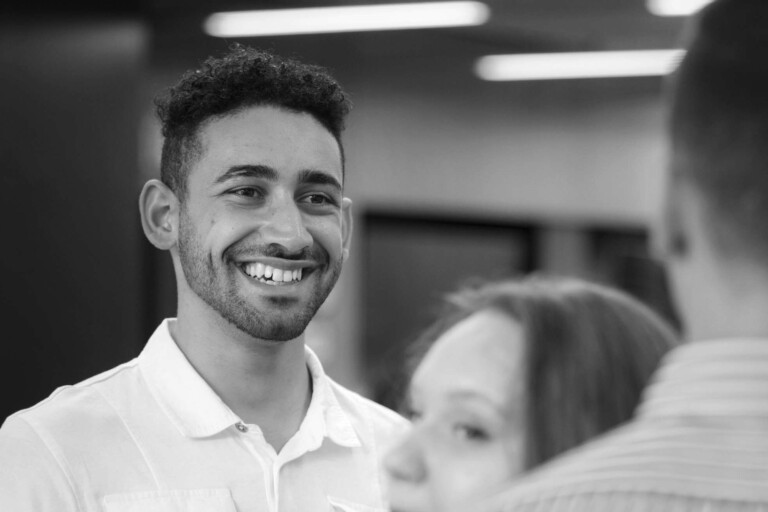Networking: why both weak and strong ties are important
– Dr Elizabeth Hartnell-Young
We live in a world of connections. But not all connections are equal. Even before Twitter, WhatsApp and Facebook, Granovetter (1983) recognised that the importance of social networks spans activities from spreading new ideas to getting a new job. He labelled the connections ‘weak ties’ and ‘strong ties’. Strong ties are people you have deep affinity with, like family, friends or colleagues.
The ‘Skyline Family’ is made up of people with strong ties, creating a supportive community. In contrast, weak ties are people you don’t know well, who can connect you to other affinity groups, including employers, politicians and sporting clubs. Granovetter found that within a network of strong ties, people with weak ties outside the core network are ‘bridges’ to other networks.
The network on the left has strong ties, so would be a very supportive group. Fortunately a couple of members also have connections to a bridge: someone with strong connection to another network. These bridges have access to new and unique information — like job openings — relative to other members of the network with only strong ties. Say, for example, that you’d like to study architecture but you are the first in family to look to university and you don’t know any architects. You need a weak tie, an introduction to someone who can share information and share their connections. Granovetter’s argument supports a diversity of connections, rather than a homogenous group.
Networking skills are strongly associated with intergenerational transfer of resources (Bourdieu, 1986). Networks of mixed ages can therefore be particularly valuable. As a Skyline Ambassador said recently, ‘connecting with young people gives older people hope’. Young Skyliners bring unique experiences: speaking multiple languages, skills in new technologies and resilience beyond measure.
Personal geography can give us a strong local network, while weak ties can increase the size of the area we operate in, reaching from our school, Melbourne and Victoria, to ‘the world is our oyster’.
Professor Martin Ruef of Duke University studies entrepreneurship and social networks ( see Strengthen Your Network With Weak Ties (evantarver.com). He has discovered that a small number of entrepreneurs cultivate a social network filled with weak ties and unlikely relationships. They are the types of people who chat with industry professionals and random strangers alike, putting importance on each type of tie. When Ruef considered a measure of innovation – trademarks and patents – he found that entrepreneurs with social networks full of weak ties were three times more innovative than people with networks filled with strong ties. He concludes that it is important to network widely, not only with ‘people like us’.
Other researchers have found that networking skills are beneficial to adjustment, wellbeing and attainment in academic settings. In a study of college students in the US, Lee and Chen (2017) considered the concepts of cultural capital, techno-capital and networking skills of college students. They argue that networking skills are a cultural competency developed from an early age and over an extended period. Cultural capital equips people with a toolkit for navigating their social world. Events like Skyline’s Masterclasses build this sort of cultural capital.
Lee and Chen also found that digital cultural production – actively engaging in creative online expression of one’s cultural taste – is positively related to greater networking skills. For Professor Neil Selwyn of Monash University, the ability to generate creative content is crucial to thrive in the global economy, and an important indicator of technological capital. He suggests that this equips users with not only competence and concepts but also connections, three key intangible assets (Selwyn, 2004).
However it’s important to manage your online presence. Who would want prospective employers to find images of wild parties or insensitive comments made in the heat of the moment? But beyond risk management it is wise to build up your online presence through public networks so that you can demonstrate your knowledge, expertise and personality to others.
Your online presence isn’t just about having something like a LinkedIn account, but about evaluating how all of your social media accounts contribute to the big picture of who you are and what you value. Twitter, WordPress, Instagram and many other accounts can positively contribute to your online presence.
It is often said that asking for ‘advice’ rather than asking for ‘a job’ is a good strategy for ambitious people. This is why Pat Hedley, author of Meet 100 People (Hedley, 2017) the key to building a robust professional network is to regularly meet – in person – with interesting people. They can be new acquaintances, colleagues you’d like to get to know better or people you’ve admired from afar. The overarching goal, she says, is to expand your network beyond your existing peer group and current contacts. Others have found that digital connections can be just as valuable.
Working as a business development manager in Melbourne, Kaley Chu had surrounded herself with similar people – native Cantonese speakers – since she came from Hong Kong to attend university. In her book 100 lunches with strangers she tells how she contacted people who might help improve her English, when a lunch with a billionaire changed her way of looking at the world (Chu, 2019).
Skyline’s network of strong ties provides a safe space for building capital while its access to weak ties in many walks of life leads to many opportunities for everyone.
References
- Bourdieu, P. (1986). The Forms of Capital. In J. G. Richardson (Ed.), Handbook of Theory and Research for the Sociology of Education (pp. 241-258). New York Greenwood Press
- Chu, K. (2019). 100 Lunches with strangers: a simple way to step out of your comfort zone and transform your life. Kaley Chu Publishing.
- Granovetter, M. (1983). The Strength of Weak Ties: A Network Theory Revisited. Sociological Theory, 1, 201–233.
- Hedley, P. (2017). Meet 100 People: A How-To Guide to the Career and Life Edge Everyone’s Missing.
- Lee, K. S., & Chen, W. (2017). A long shadow: Cultural capital, techno-capital and networking skills of college students. Computers in Human Behaviour, 20, 67-73.
- Selwyn, N. (2004). Reconsidering political and popular understandings of the digital divide. New Media and Society, 6(3), 341-362. doi:10.1177/1461444804042519

